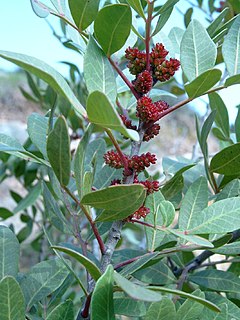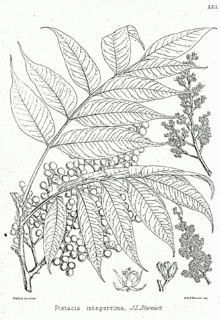
The pistachio, a member of the cashew family, is a small tree originating from Central Asia and the Middle East. The tree produces seeds that are widely consumed as food.

In polymer chemistry and materials science, resin is a solid or highly viscous substance of plant or synthetic origin that is typically convertible into polymers. Resins are usually mixtures of organic compounds. This article focuses on naturally occurring resins.

Pistacia lentiscus is a dioecious evergreen shrub or small tree of the genus Pistacia, growing up to 4 m (13 ft) tall which is cultivated for its aromatic resin, mainly on the Greek island of Chios.
The Oxford English Dictionary gives the etymology of teil as Latin tilia and Old French til. In Modern French it is tilleul. The French and Latin word cognates appeared amongst the English literate classes starting in the 14th century. Most names of trees, however, kept their Germanic origins, hence linden and lime. The linden or til tree is native to northern Europe and Asia. In various versions of Protestant Bibles the til is sometimes confused with the terebinth, which is a tree native to southern Europe, North Africa, and the Middle East. One variety of terebinth furnishes the pistachio nut and the thick bark of the tree is a source of a highly valued varnish and particular turpentine. The English and French translations in the Roman Catholic Douay Bible from the Vulgate do not confuse the two trees.

Pistacia is a genus of flowering plants in the cashew family, Anacardiaceae. It contains 10 to 20 species that are native to Africa and Eurasia from the Canary Islands, all of Africa, and southern Europe, warm and semidesert areas across Asia, and North America from Mexico to warm and semidesert United States, such as Texas or California.

Turpentine is a fluid obtained by the distillation of resin harvested from living trees, mainly pines. Mainly used as a specialized solvent, it is also a source of material for organic syntheses.

The Valley of Elah or Ella Valley, called in Arabic: وادي السنط, Wadi es-Sunt, is a long, shallow valley in Israel and the West Bank best known as the place described in the Old Testament where the Israelites were encamped when David fought Goliath. It is home to several important archaeological sites, including those identified as the ancient towns of Azekah and Socho (17:1). Rising up from the valley on its extreme southeast end lies the hilltop ruin Adullam, and on its north lie the ruins of the ancient fortress city of Khirbet Qeiyafa.

The terebinth, also called the turpentine tree, is a deciduous tree species of the genus Pistacia, native to the Mediterranean region from the western regions of Morocco and Portugal to Greece and western and southeastern Turkey. At one time terebinths growing on the eastern shores of the Mediterranean Sea were regarded as a separate species, Pistacia palaestina, but these are now considered to be a synonym of P. terebinthus.
Mastic tree is a common name for several plants and may refer to:
Turpentine weed is a common name for several plants and may refer to:

Syncarpia glomulifera, commonly known as the turpentine tree, or yanderra, is a tree of the family Myrtaceae native to New South Wales and Queensland in Australia, which can reach 60 metres (200 ft) in height. It generally grows on heavier soils. Crushed leaves have a taste and smell reminiscent of turpentine. The cream flowers appear in spring and are fused into compound flowerheads.
Turpentine bush may refer to:
Ella is most often used a feminine given name, but also occurs as a surname, especially in Australia.

Pistacia atlantica is a species of pistachio tree known by the English common name Mt. Atlas mastic tree, Cyprus turpentine tree, and the Persian turpentine tree. Pistacia ranges from shrubs to trees adapted to drought and the Mediterranean climate. P. atlantica has three subspecies or varieties which have been described as cabulica, kurdica, and mutica.

Mastic is a resin obtained from the mastic tree. It is also known as tears of Chios, being traditionally produced on the island Chios, and, like other natural resins, is produced in "tears" or droplets.
P. atlantica may refer to:

Pistacia integerrima is a species of pistachio tree native to Asia, commonly called zebrawood. It is often classified as Pistacia chinensis ssp. integerrima. It is used for a variety of purposes in India, including timber, dye, and fodder. The leaf galls are used in traditional herbalism for cough, asthma, fever, vomiting, and diarrhea.

Lane Cove Bushland Park is located in suburban Lane Cove, 5 kilometres from the centre of Sydney, Australia. It is regarded as one of the more interesting areas of fungi in the country. In the year 2000, Bushland Park was placed on the Register of the National Estate, under the Australian Heritage Commission Act, 1975. Average annual rainfall is 1220 mm. Soils are moderately fertile, based on Hawkesbury sandstone and Ashfield Shale. The climate is warm and humid.

Beyeria Conservation Park is a protected area in the Australian state of South Australia located on Kangaroo Island in the gazetted locality of Haines, about 16 kilometres south of Kingscote on the northern edge of the MacGillivray Plain.
Pistacia eurycarpa, or the Kurdish turpentine tree, is a species of Pistacia native to Turkish Kurdistan, Iraqi Kurdistan, Iran, Armenia, and Antilebanon. It is called qezwan (قەزوان) or dareben (دارەبەن) in Kurdish.












